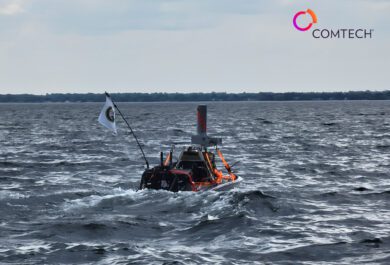For decades, satellite communications systems operated under a comforting illusion: that their physical distance from terrestrial networks and their specialized nature offered a kind of built-in security. In many ways, the industry believed it was flying under the radar—too niche, too remote, too complex to be a target.
That illusion has been shattered.
Today, satellite systems are not only visible to adversaries—they are increasingly attractive targets. The metaphor of the unlocked front door fits uncomfortably well. Many systems are still deployed with outdated assumptions about who might try the handle. And in a world where cyber threats are growing in sophistication, scale, and intent, that kind of complacency is no longer acceptable.
The New Cyber Battleground
The satellite domain—once considered obscure—is now a fully contested cyber terrain. Recent research into commercial satellite modems revealed 16 vulnerabilities across nine devices. These vulnerabilities ranged insecure legacy protocols and insecure firmware update paths to exposed web interfaces and physical debug ports. In many cases, basic protections like encryption were disabled by default—leaving systems wide open to interception, manipulation, or disruption.
Another study, Cyber Attacks on Space Information Networks (2025), categorized threats into passive (eavesdropping) and active (spoofing, jamming, denial-of-service, hijacking). It highlighted how the increasing complexity of space systems, reliance on commercial off-the-shelf (COTS) components, and lack of standardized security frameworks have expanded the attack surface dramatically.
The Microsoft Digital Defense Report adds further urgency. It shows that adversaries—ranging from nation-state actors to cybercriminal syndicates—are becoming more agile, more collaborative, and more capable. They are exploiting technical debt, infiltrating supply chains, and targeting critical infrastructure with increasing precision. Satellite systems, once considered peripheral, are now central to their strategies.
Why This Matters for Defense and Commercial Operators Alike
For the U.S. Department of Defense and allied military forces, satellite communications are not a luxury—they are a lifeline. SATCOM enables global command and control, real-time intelligence sharing, logistics coordination, and resilient communications in denied or degraded environments. It is foundational to modern military operations.
But the commercial sector is no less exposed. Enterprises rely on satellite networks for everything from maritime and aviation connectivity to oil and gas operations, disaster response, and financial transactions. A successful cyberattack on a commercial satellite link or gateway could disrupt services across continents, compromise customer data, or even impact national economies.
Whether the mission is tactical or transactional, the stakes are high. And the vulnerabilities are shared.
The Legacy Challenge
One of the most significant challenges facing the SATCOM industry is legacy inertia. Many satellite systems in use today—both military and commercial—were designed in an era when physical isolation was considered sufficient protection. These systems were built for reliability, not cybersecurity. They were engineered to survive radiation, temperature extremes, and orbital debris—not ransomware, firmware tampering, or zero-day exploits.
Retrofitting security into these legacy systems is difficult—but not impossible. It requires a disciplined, layered approach that balances operational continuity with modern defensive engineering.
At Comtech, we are actively addressing this challenge. We are modernizing our platforms with secure-by-design principles, integrating memory-safe languages like Rust into our next-generation firmware, and adopting layered defense strategies that include sandboxing, secure wrappers, and runtime anomaly detection.
The Response Must Be Multi-Layered
Cybersecurity in the space domain cannot be an afterthought. It must be engineered into every layer of the system—from firmware and hardware to cloud orchestration and ground control. The response must be multi-layered, proactive, and resilient.
Here’s what that looks like in practice:
- Zero Trust Architectures
Zero Trust means no implicit trust—anywhere. Every component, whether onboard a satellite, in a ground station, or in a cloud-based control system, must authenticate itself and operate under the principle of least privilege. Communications must be cryptographically signed and verified. Mutual attestation should be standard. - Secure Boot Chains and Authenticated Firmware Updates
Every stage of a system’s boot process must verify the integrity and authenticity of the next. This prevents rollback attacks, firmware tampering, and unauthorized code execution. Firmware updates must be cryptographically signed, integrity-checked, and delivered through secure channels.
Given the long life cycles of satellite systems, the ability to securely patch and update firmware in the field is essential. - Cryptographic Agility
Satellites and ground systems often remain in service for 15 to 30 years. During that time, cryptographic standards evolve, and new threats emerge. Systems must be designed with cryptographic agility—the ability to upgrade algorithms, rotate keys, and transition to post-quantum cryptography without requiring hardware replacement.
Hard-coded keys, static certificates, and inflexible crypto stacks are liabilities. Agility is the only sustainable path forward. - Memory-Safe Software Development
Many vulnerabilities in legacy systems stem from memory corruption—buffer overflows, use-after-free errors, and pointer bugs endemic to C and C++. These bugs are not just common—they are exploitable.
Memory-safe languages like Rust offer strong compile-time guarantees that eliminate entire classes of these bugs without sacrificing performance. At Comtech, we are already integrating Rust into our next-generation platforms and using it to harden critical modules, such as control planes, drivers, and cryptographic libraries.
Where full rewrites are infeasible, we use secure wrappers, sandboxing, and boundary checks to isolate risky components. We also employ static analysis, fuzz testing, and sanitizers to catch vulnerabilities early in the development lifecycle. - Runtime Monitoring and Anomaly Detection
Even the most secure systems can be breached. That’s why continuous monitoring is essential. Systems must be able to detect abnormal packet flows, message integrity violations, or suspicious configuration changes in real time.
Anomaly detection, combined with automated response mechanisms, can help contain threats before they escalate. This is especially critical in space, where manual intervention may be delayed or impossible.
Defense in Depth
No single control is sufficient. Effective cybersecurity requires overlapping safeguards—encryption, access controls, rate-limiting, replay protection, and more. If one layer fails, others must still defend.
This principle of defense in depth is especially important in hybrid architectures, where satellite systems interface with cloud platforms, terrestrial networks, and mobile endpoints. Each interface is a potential attack vector—and each must be secured.
What Comtech Is Doing
At Comtech, we are embedding cybersecurity into every layer of our Satellite & Space segment. Our Digital Common Ground (DCG) portfolio includes secure firmware, authenticated update mechanisms, supply chain integrity checks, and runtime monitoring.
We call on our partners, customers, and suppliers—across both defense and commercial sectors—to:
• Demand baseline security certifications (e.g., FIPS 140-3, Common Criteria)
• Insist on transparent firmware toolchains and secure software development lifecycles
• Conduct independent security audits, red-teaming, and penetration testing
• Develop cyber incident response plans tailored to space systems
• Participate in industry-wide threat intelligence sharing and best practice development
We also support efforts to establish uniform security frameworks for space systems, including those led by the Space ISAC, the National Institute of Standards and Technology (NIST), and allied defense organizations.
A Strategic Imperative for the Next Decade
The front door has been left unlocked for too long. The combination of documented vulnerabilities, increasing threat sophistication, and the criticality of space systems demands urgent, principled reinvention.
This is not just a technical challenge—it is a strategic imperative. The next decade’s winners in SATCOM will not be those who treat cybersecurity as a bolt-on feature. They will be the ones who treat space systems as mission-critical cyber assets—designed, built, and operated with security at their core.
At Comtech, we are committed to leading that transformation. We are investing in secure-by-design architectures, modernizing our legacy platforms, and partnering with both defense and commercial customers to build the resilient communications infrastructure the future demands.
Because in today’s contested, congested, and connected battlespace—and marketplace—resilience is not optional. It’s essential.
Forward-Looking Statements
Certain information in this blog post contains statements that are forward-looking in nature and involve certain significant risks and uncertainties. Actual results and performance could differ materially from such forward-looking information. The Company’s Securities and Exchange Commission filings identify many such risks and uncertainties. Any forward-looking information in this press release is qualified in its entirety by the risks and uncertainties described in such Securities and Exchange Commission filings.



